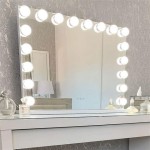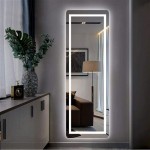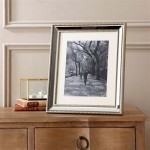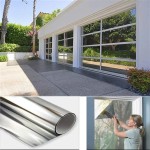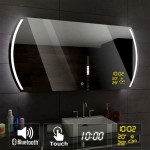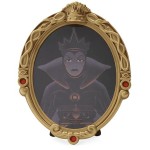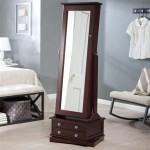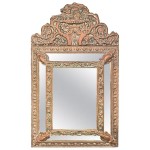Vintage Frameless Mirrors: A Retro Reflection
Vintage frameless mirrors offer a unique blend of minimalist aesthetics and historical charm. Their sleek, unadorned surfaces can seamlessly integrate into various interior design styles, while their age and history imbue them with a character that mass-produced contemporary mirrors often lack. This article will explore the appeal of these mirrors, their history, identification characteristics, and considerations for incorporating them into modern décor.
The absence of a frame draws attention directly to the reflective surface, creating a sense of spaciousness and emphasizing the mirror's functional purpose. This minimalist quality makes vintage frameless mirrors particularly well-suited to smaller rooms or spaces where a framed mirror might feel visually heavy. Moreover, the lack of ornamentation allows the mirror to complement a wide range of design aesthetics, from mid-century modern to minimalist and even traditional styles.
The history of frameless mirrors is intertwined with the development of mirror-making technology. Early mirrors were often small and expensive due to the complex process involved in creating the reflective surface. As manufacturing techniques improved, larger sheets of glass could be silvered, leading to the increased availability of affordable mirrors. Frameless mirrors, particularly those produced in the mid-20th century, often reflect this transition, showcasing the clarity and size achievable with improved manufacturing processes.
Identifying a truly vintage frameless mirror involves careful examination of several key features. The glass itself can provide clues to its age. Older mirrors might exhibit slight imperfections or waviness in the reflective surface, a characteristic less common in modern float glass mirrors. The edges of the mirror can also be telling. Vintage mirrors may have beveled edges, either subtly or dramatically angled, created through a grinding process. The thickness of the glass can also be an indicator; older mirrors are often thicker than their contemporary counterparts.
The backing of the mirror is another crucial area for examination. Vintage mirrors might have a silvered backing, which can tarnish or show signs of age. Other backings might include protective coatings or paint. Looking for signs of wear, patina, or markings on the backing can provide further evidence of the mirror’s age and authenticity. It’s also worth noting that some vintage frameless mirrors might have remnants of adhesive or mounting hardware, indicating previous installation methods.
Integrating vintage frameless mirrors into contemporary interiors requires thoughtful consideration of their size, shape, and placement. Larger frameless mirrors can create a dramatic focal point in a living room or dining area, while smaller ones can be used effectively in bathrooms or hallways. Grouping multiple frameless mirrors of varying sizes can create an intriguing visual display, adding depth and dimension to a wall. Consider the existing décor and furniture when choosing the placement of a vintage frameless mirror. It can be used to reflect light, enhance a view, or simply add a touch of understated elegance to a room.
Mounting options for vintage frameless mirrors vary depending on the mirror’s size, weight, and the desired aesthetic. Traditional methods include using clips, J-channels, or adhesive. For larger or heavier mirrors, professional installation is recommended to ensure secure and safe mounting. When choosing a mounting method, it's essential to consider the wall material and the mirror’s fragility. Avoid methods that might damage the mirror’s edges or backing.
Maintaining a vintage frameless mirror requires gentle cleaning and careful handling. Avoid using harsh chemicals or abrasive cleaners, which can damage the reflective surface or any existing backing. A soft cloth dampened with water or a mild glass cleaner is usually sufficient for removing dust and fingerprints. When handling a vintage frameless mirror, support it from the bottom and edges to prevent cracking or chipping. Proper storage is also crucial. Store the mirror in a dry, climate-controlled environment, away from direct sunlight and extreme temperatures.
The increasing popularity of vintage and antique items has brought renewed interest in frameless mirrors from past eras. These mirrors offer not just a reflective surface but also a glimpse into the design sensibilities and manufacturing techniques of their time. Their simple elegance and adaptability make them a versatile choice for a variety of interior design styles, offering a timeless appeal that transcends fleeting trends.
Sourcing vintage frameless mirrors can involve exploring antique shops, flea markets, online auctions, and estate sales. When purchasing, carefully inspect the mirror for any damage or imperfections. Consider its size and shape in relation to the intended space, and factor in any potential restoration or mounting costs. Authenticating a vintage mirror can be challenging, so researching comparable pieces and consulting with antique dealers can be beneficial.

50s Vintage Long Frameless Mirror Wavy Retro Design Mid Century

50s Vintage Long Frameless Mirror Wavy Retro Design Mid Century

Original Vintage Retro Frameless Bevelled Mirror Shield Shape C 1950 S

Minimalist Retro Mirror Oddhaus Vintage

Large Antique Vintage Frameless Art Deco Mantle Mirror Bevelled Etched Retro

Vintage Bevelled Edge Wall Mirror Art Deco Frameless Beveled

Beautiful Vintage Retro Art Deco Frameless Bevelled Edge Wall Mirror 46cm

Vintage Beveled Mirror Art Deco 1930 S Retro Frameless Antique Espejos

Beautiful Vintage Retro Art Deco Frameless Bevelled Edge Wall Mirror 46cm

Vintage Retro Round Frameless Wall Mirror Bevel Edge Masterfind

